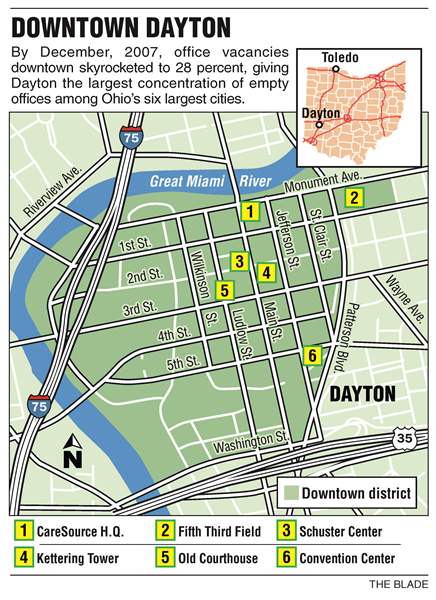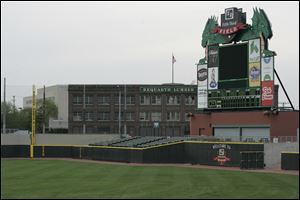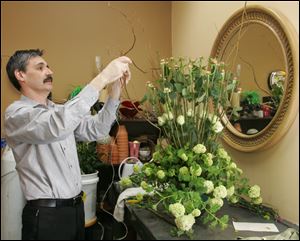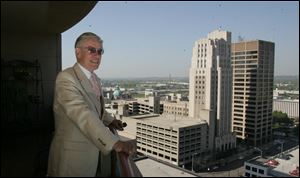
DOWN BUT NOT OUT
Difficulties in Dayton feel familiar to Toledo
Office vacancies top Ohio big cities
6/23/2008

Downtown Dayton has a Fifth Third Field, just like Toledo, along with empty storefronts and old, vacant office buildings
DAYTON -- When Mitch Bennett and a partner revealed plans to open a floral shop in downtown Dayton, friends "asked us if we lost our minds," he recalled.
And it looked as if the naysayers might be right when, shortly after Mitchell's Floral Gallery opened on the ground floor of an office tower at 110 North Main St. last year, another downtown employer announced plans to pull up stakes.
By December, office vacancies downtown skyrocketed to 28 percent, giving Dayton the largest concentration of empty offices among Ohio's six largest cities, according to reports from commercial realty company CB Richard Ellis.
Yet one year after opening, Mr. Bennett and partner Vincent Cerrito II reported that the shop, which caters to downtown office workers, has slightly exceeded sales projections.
"We're pleased, especially with the way the economy is," Mr. Bennett said.
For a Toledoan, downtown Dayton has a familiar feel.
READ MORE: Down But Not Out series
Baseball fans can catch a minor-league game at Fifth Third Field. Restaurant choices include Spaghetti Warehouse. In the skyline is a 20-story office tower called Fifth Third Center. And the downtown area is littered with empty storefronts and vacant, old office buildings.
Along South Ludlow Street at West 4th, an ornate 10-story structure christened the Commercial Building in another century has boarded and broken windows. Next door, paint peels from another forlorn building with top-floor windows covered by yellowed venetian blinds that are askew.
And the similarities between Dayton and Toledo don't end there.
The two cities are similar statistically.
Dayton was the only big city in Ohio that exceeded Toledo's downtown office vacancy rate of 22 percent at the end of 2007, according to CB Richard Ellis.
At one point in 2007, five downtown Dayton office buildings were in foreclosure.
Comparing population, Dayton is the state's fourth largest metro area, with just under 836,000 people, ahead of sixth-place Toledo, which has about 651,000 people.
But more metro residents (292,584) live inside Toledo's city limits, giving the Lucas County community a population almost twice as large as the Montgomery County city.
And downtown employment is slipping in both cities.

Mitch Bennett and his partner said their fl oral shop, which caters to offi ce workers in downtown Dayton, slightly exceeded sales expectations in the fi rst year after opening.
Slide in employment
In Dayton, employment in the area around the downtown improvement district, established by merchants under Ohio law, declined by 6,575, or 26 percent, to 18,411 between the start of the decade and 2005, according to a U.S. Census Bureau report. Those employees worked at 913 businesses, 92 fewer than in 2000.
In Toledo, the Census Bureau counted 17,737 private-sector employees in 2005 in ZIP codes included in the downtown special improvement district for a loss of 2,227 workers, or 11 percent since 2000. There were 925 businesses, or 58 fewer than when the decade opened.
The reports don't include government employees. About 65,000 of metro Dayton's 400,000 workers are employed in government, but it is unclear how many are downtown.
The nonprofit Downtown Dayton Partnership counts 23,600 total workers, including government employees.
Although boosters don't agree with the Census Bureau's estimate of the size of the losses, they don't dispute that jobs have disappeared.
"That trend is continuing even today," said John Gower, Dayton director of planning and community development. "We are in the midst of a repositioning of our downtown that's taking a generation."
A place to live
The solution to declining work rolls, city officials said, is to persuade more people to move downtown.
For pre-World War II office buildings emptied by fewer jobs, one solution is to offer developers incentives to convert them to condos and apartments.
The last time the Census Bureau checked, in 2000, the downtown had 2,040 residents. Boosters say the population is up, but they don't know by how much. Developers have added 420 market-rate apartments and condos since the beginning of the decade, increasing downtown's housing stock by nearly one-third to 1,810 today, said Sandy Gudorf, president of Downtown Dayton Partnership Inc.
New residents include Ed Rhodes, a retired school principal.
The 66-year-old and his wife settled a year and a half ago in a 15th-floor condo connected to downtown's Schuster Performing Arts Center.
Performance Place, with 32 upscale units, was designed to appeal to arts lovers.
"We go to all events at the center," Mr. Rhodes said. "During intermission, we can come up, do what we need to do, and go back."
Two-bedroom condos there sold for $275,000 to $435,000.
Although visitors complain about a lack of night life and limited restaurant choices in the city core, Mr. Rhodes doesn't regret his move from the suburbs.
"It's amazing to watch the sky and the moon from this high up," he said. "We're working on getting a grocery store. ... But my bank, a CVS Pharmacy, and the post office are across the street. My church is two blocks away, and the ballpark is nearby."

A targeted approach
City planners said they have tried to avoid the sort of scattered revitalization efforts that are hindering downtown redevelopment in many cities. The key to success, Mr. Gower said, is to concentrate on downtown's Main Street to ensure that it has a nucleus around which other redevelopment can spread.
Recent successes have included a decision by Dayton's CareSource Management Group, a fast-growing firm specializing in managed medical care, to build a $55 million headquarters at Main and Monument Avenue.
The glass-and-aluminum structure, to be completed by the end of the year, will eventually house 1,200 CareSource employees, a company spokesman said.
The project was a rare home run for the downtown office market.
Defections include paper producer NewPage Corp. and engineering firm Woolpert Inc., which left for the suburbs over the last two years.
The NewPage departure created a hole in the 28-story MeadWestvaco Building, Dayton's second-tallest office building behind 30-story Kettering Tower.
Cleaner and safer
Nearby, Dayton's Litehouse Development Group is building the first of 40 planned townhouses across from Fifth Third Field. The units, which are environmentally friendly modular structures, are priced at $175,000 to $280,000. Developers hadn't scored any sales in the development's first three weeks but are optimistic the project will succeed, said Margie Rivera, a Litehouse spokesman.
Tom Harris, who owns and operates the Southern Belle nightclub across from the site, welcomes the project. But he is skeptical. He said developers have been talking about the project for three years.
His bar is full on nights when the Dayton Dragons play but slow at other times.
"Nobody's got any money," he said. "With the economy, it's killed business."

Ed Rhodes, a retired school principal, enjoys the view from his 15th-fl oor condo near Dayton’s performing arts center.
Still, he praises downtown redevelopment efforts, saying they have made the area cleaner and safer.
Twenty-five-year-old J.T. Neal, of suburban Englewood, agreed. He and a friend were in town to watch the hometown baseball team defeat the Cedar Rapids Kernels 10-3 before nearly 8,000 fans at Fifth Third Field.
"For the last five years, downtown has improved a lot," he said.
Those improvements have been eased by the proximity of 23,000 students at Sinclair Community College as well as by the upscale Oregon Historic District, development officials said.
The historic district is a four-block stretch of shops and restaurants surrounded by a residential area with restored 19th-century homes and streets lined with German and Japanese-brand cars. Boosters are pursuing a plan to create a major arts district in the neighborhood.
'Something lacking'
Along South Ludlow Street near West 5th Street, the scene is far different. Loudspeakers pumped David Gray's "Babylon" from a downtown restaurant to sidewalks devoid of people.
Janet Converse, who has worked in downtown Dayton for 24 years, apologized for the absence of activity during the noon hour on a bright spring day.
"This end of downtown used to be busier," the 59-year-old state employee said.
Not far away, Marcia Coffield, a 53-year-old office worker, sat on a bench in a park along the Great Miami River enjoying the noon sun.
She attends ball games and cultural events downtown but said: "It still seems to be that there is something lacking downtown. ... It's improving a little, but I've seen a lot of restaurants come and go from the same location."
Don Chernick, 70, has owned businesses downtown since 1952. Currently he operates Gallery Jewelers in the arcade of an office tower.
"I've seen downtown good and I've seen downtown bad," he said. "But I won't give up on it."
Contact Gary Pakulski at:
gpakulski@theblade.com
or 419-724-6082.